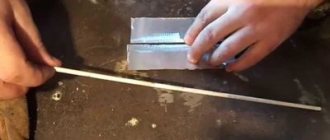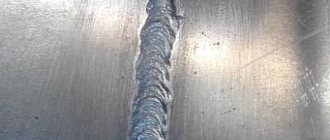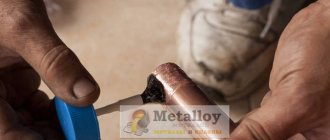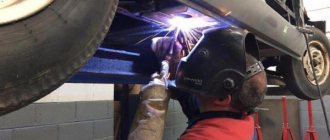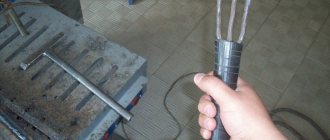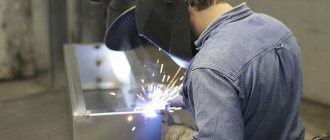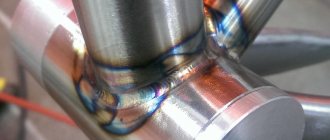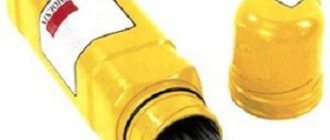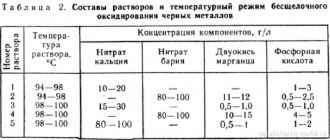The highest quality and most beautiful seams are obtained if stainless steel is joined by semi-automatic welding under argon protection. But not every home craftsman has the opportunity to purchase expensive equipment and gas. When the aesthetics of the connection is not important, the required quality is achieved by welding stainless steel with an inverter.
Inverter selection and configuration
An inverter is a source that provides ignition and stability of the welding arc. The operation of the device is based on the principle of converting alternating current of industrial frequency into direct or alternating current of the required frequency and voltage.
Different models of devices operate from a 220 V household network, are small in size, low in cost, and are easy to use and transport. When welding stainless steel, in order to obtain a high-quality weld, it is necessary to set the converter settings depending on the thickness of the workpiece.
Optimal inverter modes, electrode diameters.
| Product thickness, mm | Voltage, V | Current strength, A | Electrode thickness, mm |
| 1,5 | 13 | 40–60 | 2 |
| 3 | 15 | 75–85 | 3 |
| 4 | 16 | 90–100 | 3 |
| 5 | 18 | 140–150 | 4 |
Welding stainless steel at home can be done with an industrial or homemade inverter with the required performance indicators. Basic conditions: the presence of a manual arc welding (MMA) mode, current range from 20 to 200 A. Please note that some device models do not function at low ambient temperatures.
Manual arc welding diagram
This is interesting: Direct and reverse polarity when welding
Welding inverter
High-quality electric welding of stainless steel with an inverter requires the selection of the appropriate apparatus. The welding inverter acts as a power source to form the arc. The device must operate stably so that the power supply is constant and does not change its parameters during the process. There should also be a convenient selection of settings that will help you select the correct voltage and current for a particular case. This also determines what maximum diameter electrodes can be used.
Inverter welding machine
Do not forget about easy ignition, since this operation begins the process and the device must provide the necessary conditions. The more powerful the equipment, the larger its size, and it can also work with thicker metals. Recently, compact inverters have become very popular for private use. They also have a high efficiency.
Stages of the welding process
Compliance with the sequence of actions when welding stainless steel will guarantee a reliable connection of the workpieces. The main technological steps are as follows:
Electrode position when welding
- Use a wire brush to clean the area where the parts combine to remove debris, paint, and excess inclusions.
- Pre-calcinate the electrodes in accordance with the instructions.
- Using available tools, cut the edges into a specific shape corresponding to the thickness of the parts being welded.
- Treat edges and surfaces with solvent.
- Sheets of steel with a thickness of more than 7 mm are heated to 150 ºC with a blowtorch.
- Place copper pads under the parts to ensure heat dissipation.
- Weld with a short arc, avoiding oscillatory movements. You can hold the electrode with an inclination of 40–60º to the surface.
- To obtain a “lock” that prevents cracks, remove the weld pool from the processing area and interrupt the arc.
- Leave the product to cool naturally.
- After welding stainless steel, beat off the slag, clean the seam, grind or polish the finished product.
Selection of products according to other parameters
The type of current, as well as the polarity of its connection, are the most important parameters of welding operations. Welding inverters primarily produce direct current, which can be connected to the workpiece and the electrode in two circuits.
- Straight polarity. With this scheme, the plus is connected to ground, and the minus to the welding electrode.
- Reverse polarity. This scheme involves connecting the minus to ground, and the plus, respectively, to the holder with the electrode.
If you cook with an inverter using straight polarity, the surfaces being connected are subject to significant heating, which does not happen when connecting the polarity in the opposite way. This is why choosing reverse polarity is advisable in the following situations.
- When welding parts of small thickness with an inverter. Reverse polarity in such cases will help protect the material from burn-through.
- Reverse polarity is used to weld parts made of high-alloy steels, which are very sensitive to overheating.
Working with inverter welding
Direct polarity, during which the workpiece is subjected to significant heating, is optimally used for joining materials that are very thick and massive.
When performing any welding work using an inverter, the most significant are three parameters that are interconnected:
- welding current strength;
- electrode diameter;
- thickness of the parts to be connected.
The thickness of the parts being connected has a direct influence on the choice of electrodes. If it is necessary to connect thin parts (up to 1.5 mm), manual welding is not used; semi-automatic machines or devices that allow welding in a protective argon environment are better suited for this purpose.
Options for electrode position when welding
When deciding which electrodes to choose for welding structures of a certain thickness, you can be guided by the following criteria:
- for parts whose thickness is 2 mm, electrodes Ø 2.5 mm are best suited;
- when connecting parts with a thickness of 3 mm, you should choose electrodes Ø 2.5–3 mm;
- if the thickness of the parts to be welded is 4–5 mm, then electrodes Ø 3.2–4 mm are suitable;
- parts with a thickness of 6–12 mm are best welded with electrodes Ø 4–5 mm;
- when the thickness exceeds 13 mm, then the optimal choice is electrodes Ø 5 mm.
Welding electrodes
If such information is not contained on the packaging, then you can follow the following recommendations:
- for welding with electrodes Ø 2 mm, the welding current should be set to 55–65A;
- for products Ø 2.5 mm, a current of 65–80A is used;
- electrodes Ø 3 mm - current 70–130A;
- for electrodes Ø 4 mm, choose a welding current of 130–160 A;
- products Ø 5 mm - current 180–210 A;
- It is better to cook with 6 mm electrodes at a current of 210–240 A.
As it becomes clear from all of the above, for high-quality welding with an inverter, the correct choice of electrodes according to their diameter is important. You should also set the optimal welding current. If, for example, you plan to weld thin metal with an inverter, using large-diameter electrodes, or the welding current exceeds the permissible values, then pores may form in the finished weld, which will significantly reduce its quality characteristics.
Setting up the device
Before welding stainless steel with an inverter, you need to set the settings using the switches on the front panel in accordance with the parameters of the workpieces being joined. The magnitude of voltage and current depending on the thickness of the parts is determined from the table:
| Metal thickness, mm | Electrode diameter, mm | Voltage, V | Current value, A |
| 1,5 | 2 | 13 | 40 — 60 |
| 3 | 3 | 15 | 75 — 85 |
| 4 | 3 | 16 | 90 — 100 |
| 6 | 4 | 18 | 140 — 150 |
When performing argon-arc and semi-automatic welding, the gas flow is adjusted within the range of 6 - 12 l/min. The wire speed is set using a mode switch. The larger it is, the shallower the depth of penetration.
Welding with coated electrodes (MMA)
Welding stainless steel parts using MMA technology, which involves the use of coated electrodes, is the most common technology. This method is quite simple, it can be used at home, but it does not allow you to obtain the highest quality seam.
Conveniently, this kind of stainless steel welding can be done even at home, but for this you will need a special welding machine called an inverter. In order for welding stainless steel with an inverter to produce a highly reliable connection, it is necessary to select the correct electrode for a specific grade of stainless steel. All electrodes used to weld stainless steel products are divided into two main types:
- with a rutile coating based on titanium dioxide (welding with such electrodes, which provide small metal spatter and a stable arc, is performed with direct current and reverse polarity);
- with a coating based on magnesium and calcium carbonate (with such electrodes, stainless steel is welded using direct current of reverse polarity).
» data-lazy-type=»iframe» src=»data:image/gif;base64,R0lGODlhAQABAIAAAAAAAP///yH5BAEAAAAALAAAAAABAAEAAAIBRAA7″>
To understand which electrodes to use to weld stainless steel, just look at GOST 10052-75, which presents all types of such consumables, and also stipulates which one should be used for working with metal of a specific chemical composition. In order to select stainless steel electrodes that meet the requirements of this GOST, it is enough to know the grade of the metal from which the parts need to be connected.
All requirements for electrodes for welding stainless steel can be found by downloading GOST 10052-75 for free in pdf format from the link below.
GOST 10052-75 Coated metal electrodes for manual arc welding of high-alloy steels with special properties Download
Welding stainless steel with an electrode at home
To carry out welding at home, many performers use inverter-type devices.
Units of this type operate from a standard 200 V power source; their small dimensions and weight make it convenient to move and transport the equipment.
The relatively low cost has made this type of equipment a top seller among performers. Welding stainless steel using inverter welding creates a reliable connection.
When setting up the inverter, the following parameters should be taken into account:
- if the metal thickness is 1.5 mm, then the current should be 40-60 A, electrode Ø 2 mm.
- part thickness 3 mm: voltage 75-85 A, rod Ø – 3 mm.
- thickness 4 mm: current 90-100 A, rod Ø – 3 mm.
- thickness 6 mm. voltage 140-150 A, consumable Ø – 4 mm.
Welding is carried out with direct current of reverse polarity.
The welding process includes several stages:
- Rust, oil and other contaminants should be removed from the working surface , cleaning is carried out with a metal brush;
- The edges of a product whose thickness exceeds 4 mm must be cut. This ensures a good level of penetration and filling of the weld pool. Cutting is done with a grinder or file;
- when working with thin metal , you need to tightly bring the welded edges together and make tacks;
- product with a thickness of more than 7 mm. should be heated to 150°C. When carrying out household welding, it is recommended to do this with a blowtorch;
- work begins with igniting the arc. The electrode is brought to the surface and touched several times, thus activating it.
- connections are made on a short arc ;
- a “lock” should be made at the end of the seam to avoid the formation of cracks and fistulas;
- after finishing the welding process, you need to let the product cool, it is not recommended to do this forcibly;
- the slag crust is removed with a hammer or cleaned approximately five minutes after completion of work;
- The last step is polishing and grinding .
Useful video
This method requires electrodes used to work with corrosion-resistant and heat-resistant metals.
Electrodes intended for inverter welding of corrosion-resistant steels:
The seam made with OZL-6 electrodes is heat resistant and not prone to the formation of cracks and pores. This brand is characterized by high performance properties.
ANO-27 electrodes are intended for welding critical structures operating under static and dynamic loads, as well as at negative temperatures.
For other grades, see the sections for corrosion-resistant high-strength steels and for corrosion-resistant acid-resistant steels.
Nuances when welding stainless steel
As a rule, stainless steel is welded quite easily with an inverter if the welder understands the basic principles of working with this metal. This helps prevent common defects and create a quality connection. There are three problematic issues that require specific measures when welding stainless steel with an inverter:
- Alloy steel is characterized by increased interaction with the environment. Contact of molten metal with oxygen leads to the release of carbon and the formation of large pores on the surface of the weld. Therefore, weld metal in a liquid state needs reliable protection from external gases. For this purpose, electrodes with a special coating are used, insulating the welding zone with an artificial gas cloud. The consistency of the latter should not prevent the welder from clearly seeing the weld pool and seam.
- Extensive welding work, or holding the arc in one place for a long time, leads to overheating of the area. This entails burnout of alloying elements. When metal comes into contact with moisture, rust stains may appear. This area becomes susceptible to corrosion and, over time, leaks. Using the above machine settings, which imply a 20% reduction in current compared to welding conventional steel, and working in a staggered manner, will help preserve the anti-corrosion properties of stainless steel.
- The linear expansion of alloy steel is higher than that of the “ferrous” metal, which leads to an active invisible process inside the material. Under the influence of the arc temperature, the product in the welding zone expands, and as it cools, it contracts into place. Such invisible movement leads to the formation of microcracks and violations of the tightness of joints. Therefore, in addition to the correct settings of the device, it is necessary to correctly select the material of the filler element (electrode) that can organically interact with the base metal and not “tear” during the expansion/constriction process.
Method using an inverter
The job requires experience and is not available to every beginner.
Advantages of welding stainless steel with a conventional electrode:
- low cost of equipment;
- low weight and dimensions of the device;
- ability to weld parts up to 2 cm thick;
- possibility of working without protective gases and fluxes.
Disadvantages of this method:
- formation of a large amount of slag;
- destruction of the coating followed by overheating of the electrode;
- current limit;
- increased time costs.
The work is carried out in three ways:
- Using manual methods. The joint between the parts is filled with molten electrode material. Only an inverter is used for operation.
- Connecting workpieces with a tungsten electrode used for thin sheets. The weld is obtained by melting the workpiece and filler wire. The welding site is protected by a layer of gas.
- Semi-automatic operation with wire feeding. Speed increases along with productivity. It is recommended to add carbon dioxide (up to 2%) to argon.
Before you cook stainless steel with an inverter at home, you need to properly prepare the apparatus and materials.
Necessary consumables
Using an inverter, you need to prepare everything necessary for work:
- unit of the appropriate type;
- solvent;
- steel bristle brush;
- personal protective equipment;
- electrodes;
- crocodiles - grounding clamps;
- cables with a length of 2 to 6 m.
Joining sheets with a thickness of 3 or 4 mm and obtaining a high-quality seam becomes a difficult task, which can be accomplished using an inverter with an oscillator and the ability to carry out argon arc welding (TAW).
The popular device Aurora PRO INTER TIG 200 PULSE can become such a device. ADS allows you to create beautiful and durable seams on thin sheets or pipes.
Inverter setup
Before welding, the machine is set up correctly. This is done by switches on the instrument panel. The required values can be seen in the table:
| Workpiece thickness | Current value (A) | Voltage (V) | Electrode diameter |
| 1,5 | 40 — 60 | 13 | 2 |
| 3,0 | 75 — 85 | 15 | 3 |
| 4,0 | 90 — 100 | 16 | 3 |
| 6,0 | 140 — 150 | 18 | 4 |
| 8,0 | 150 — 180 | 20 | 4 |
| 12,0 | 180 — 220 | 22 | 5 |
| 15,0 | 220 — 260 | 26 | 6 |
When working in semi-automatic or argon-arc welding mode, the flow rate of inert shielding gas is set. Everything is done experimentally. Optimal values are 6-12 l/min. The movement of the wire during automatic feeding is adjusted to the maximum speed, which gives a high-quality seam.
Process step by step
Before work, the master must perform the following steps:
- remove dirt from the workpiece next to the future seam with a steel brush or emery cloth until it has a natural shine;
- treat the welding area with solvent or acetone to remove traces of fat;
- remove chamfers from workpieces with a thickness of 4 mm or more to fill the joint with molten metal;
- treat the rest of the metal with a solution of chalk in water so that hot drops do not stick;
- leave a compensation gap of 1-2 mm between the parts;
- connect thin sheets without gaps;
- place heat-dissipating plates under the workpieces;
- Thick parts should first be heated until they reach 150-170°C.
When working with direct current, reverse polarity is installed.
Post-weld treatment
At the end of the work, the parts are cooled naturally. You cannot speed up the process by pouring water on them. This will lead to the formation of microcracks. After cleaning the slag, the seam is ground and then polished.
For refining, abrasive materials containing aluminum or zirconium oxide are used. Corundum products are not suitable.
To ensure that the joint remains durable and aesthetically pleasing, it is coated with a paste with anti-corrosion properties. If these recommendations are not followed, the quality of the product will decrease due to the occurrence of rust spots.
Instead of a conclusion: manual welding is often used for small household and industrial problems. It is used to connect pipes, stainless steel tanks and other products in the country, in the house, in the garage. Repaired items last for many years.
This is interesting: Welding cast iron with an electrode at home using an inverter
Features of welding stainless steel parts
The main difficulties that arise when welding stainless steel are due to the fact that this material belongs to the group of high-alloy alloys, and therefore contains many different elements that determine its basic properties. So, it contains a compound such as chromium. Its share in the alloy can reach 12−30%. Chromium, like other elements contained in stainless steel - molybdenum, manganese, titanium and nickel, provides this metal with anti-corrosion properties. But at the same time, stainless steel also receives a number of features from it that affect its weldability.
Therefore, when welding stainless steel, it is necessary to take into account a number of characteristics of this material.
- High coefficient of linear expansion . Because of this feature, when welding stainless steel parts, they inevitably undergo significant deformation. Sometimes the deformation caused by this property can cause large cracks to appear if the parts prepared for joining are thick and there is no gap between them.
- Low thermal conductivity . Unlike low-carbon alloys, stainless steel has one and a half to two times lower thermal conductivity. Because of this feature, during welding, parts are fused even at lower currents than when connecting parts made of low-carbon steel.
- Intergranular corrosion . In conditions where stainless steel is subjected to strong heating during welding (up to a temperature of +500 degrees Celsius and above), one has to observe a phenomenon called intergranular corrosion. It occurs due to the fact that at the edges of the grains of the metal structure, layers consisting of chromium and iron carbide are formed.
But this phenomenon can be prevented if you take special care in choosing the welding mode, and also forcibly cool the elements being joined, which ordinary water can easily handle. But it is important to remember that this cooling method can only be used for products made of chromium-nickel steels that have an austenitic internal structure.
- Overheating of electrodes with chromium-nickel rods . Considering that the materials being welded have low thermal conductivity and increased electrical resistance, during their connection the electrodes, the rods of which consist of a chromium-nickel compound, are often heated to critical temperatures. This phenomenon can be prevented only by using electrodes for welding with a length of no more than 35 cm.
This is interesting: HSS steels - features, grades, designations, explanation
Advantages and disadvantages of the method
The method of welding stainless steel with an inverter is used in domestic conditions, when it is necessary to eliminate defects, perform surfacing on a small area of a part, or create short seams. The elements to be connected can be sheets for tanks or containers, pipes, steel structures. The main advantages of the inverter welding method:
Pros and cons of MMA welding
- the devices have small dimensions and affordable prices;
- the thickness of the welded parts can vary over a wide range;
- there is no need to use additional flux protection;
- It is possible to weld hard-to-reach areas.
The disadvantages are the need to regularly remove slag and the significant time spent on the welding process. When welding stainless steel, having skills and experience working with an inverter and electrodes will guarantee the expected result.
Where is the method most often used?
The areas in which stainless steel welding with an inverter is used are extensive due to the mobility of the inverter. It is not tied to a single place, so work can be performed both at home and in production.
Welding stainless steel with electrodes will only be useful when creating short seams. RDS is in demand in the following types of work:
- Manufacturing parts on a small scale
- Installation of metal structures. Keep in mind that this type of welding is possible provided that the amount of planned work is small
- Construction of tack welds during installation of structures for welding work
- Elimination of defects in small areas of the seam
- Surfacing
Summarizing the above, it is worth noting once again that welding stainless steel with an electrode is used if the upcoming work is not on a large scale. Therefore, the inverter connection of stainless steels is suitable for use for personal purposes and for production purposes in small areas. The elements to be connected are metal structures, stainless steel objects or pipes.
If you still intend to weld stainless steel using electrodes, then the sequence of work is described below.
Manual and semi-automatic welding of stainless steel in argon (AC/DC TIG, MIG)
To perform manual welding of stainless steel in an argon environment, tungsten electrodes are used. This technology, even at home, allows you to obtain high-quality and reliable connections for products that are not very thick. Welding with such electrodes on stainless steel is used mainly for installing communications from pipes through which gases or various liquids will be transported under pressure.
Austenitic stainless steel should be welded with particular care and caution
This technology has certain features.
- To ensure that tungsten, from which stainless steel electrodes are made, does not get into the molten metal in the welding zone, the arc is ignited in a non-contact manner. If it is not possible to do this directly on the part, then the arc is lit on a special coal plate and carefully moved to the workpieces to be joined.
- Welding stainless steel using this method can be performed with both direct and alternating current.
- The modes are selected depending on the thickness of the parts being connected. Such modes, in particular, include the parameters of the cross-section of the tungsten electrode, the diameter of the wire used as an additive, current parameters (strength and polarity), shielding gas consumption, and welding speed.
- It is very important that the alloy level of the filler wire is higher than that of the parts being joined.
- During the welding process, stainless steel electrodes should not make oscillatory movements. If this requirement is neglected, this may lead to disruption of the welding zone and oxidation of the metal in its area.
» data-lazy-type=»iframe» src=»data:image/gif;base64,R0lGODlhAQABAIAAAAAAAP///yH5BAEAAAAALAAAAAABAAEAAAIBRAA7″>
By using this technology, the consumption of tungsten electrode can be reduced. To do this, you need to keep the argon supply open for some time (10–15 seconds) after the welding process is completed. This procedure helps protect the hot tungsten electrode from active oxidation.
Semi-automatic welding of stainless steel in an argon environment, in fact, has few differences from the conventional manual method. Its main difference is that the wire is fed into the welding zone using special equipment. Thanks to mechanization, the process proceeds much more accurately and at greater speed.
Thanks to the use of semi-automatic equipment, the following welding techniques for stainless steel parts can be implemented:
- jet transfer method, which allows you to effectively weld parts of large thickness;
- short arc welding - for connecting parts of small thickness;
- Pulse welding is a universal technology that allows you to obtain high-quality and reliable connections and is the most profitable option financially.
Tig welding of stainless steel
This is interesting: Methods of processing stainless steel: the most popular options
Which inverters to weld stainless steel
When choosing an inverter device for welding stainless parts, you should pay special attention to the following indicators:
- Operating temperature range. It is of great importance, since some models cannot fully perform their functions, and are not able to weld stainless steel in too cold weather outside the room.
- Current strength and power value of the device. For connections of stainless steel parts in domestic conditions, it is recommended to use equipment with an output current of 180 amperes. Higher rates are typical for models of welding equipment used in the professional field.
- The quality of work should not be reduced if the rated mains voltage deviates within 20%.
- Additional functions are present in maximum quantities.
The correct choice of parameters has a direct impact on the quality of welded joints. However, specifications alone will not be enough without the best electrodes for the job at hand. There are also a number of factors that need to be considered when choosing this consumable before welding the parts.
Semi-automatic welding
Question #5
I'm just learning to weld. Tell us about semi-automatic welding of stainless steel. What gas is best to use for it?
Answer:
According to all theoretical canons, stainless steel welding is carried out in argon. But in practice it doesn’t turn out quite like that, or rather, a little differently. When welding in argon, welders complain about large metal spattering and an unstable arc. We won't go into the possible reasons why this happens. For example, when welding aluminum, you need to use only high-purity (highly purified) argon, otherwise similar problems arise: the weld ends up with holes, defects, scale, and welding is difficult. Thus, to weld stainless steel, you need to use high-purity argon, but in practice a mixture of argon and carbon dioxide is prepared in a ratio of 95-98% to 2-5% . In any case, all industrial work is carried out in such an environment. It is possible to replace carbon dioxide with pure oxygen in some cases. Cooking in 100% carbon dioxide is not recommended, although the thirst for experiments pushes welders to various experiments, which end in a decrease in the corrosion resistance of the weld. Carbon dioxide is best suited for “black” steels (that is, low- and medium-carbon steels), for which reason, read the article “Protection of the weld pool”
Now about technology. There are 3 ways to practice:
• Short arc welding - allows you to avoid metal penetration when joining thin sheets • Jet transfer - it is best to use flux-cored wire without gas • Pulse mode (the filler material is supplied in portions in small drops) - the best method, it allows you to almost completely get rid of spatter and reduce wire consumption .
Question #6
Hello! The difficulty is this: it’s impossible to adjust the wire feed speed of a semi-automatic machine. I weld stainless steel. Protective medium carbon dioxide. The seam turns out to be of poor quality, the arc breaks. When the arc is ignited, the wire burns up to the burner. How to set up a semi-automatic machine?
The difficulty arose due to incorrectly selected welding modes. When selecting modes, focus on 2 main parameters: at what speed the wire is fed and what is the voltage at the power source.
First, you select the speed at which the wire will be fed. The speed is selected based on the thickness of the product. Speed is also related to current. The higher the feed speed, the greater the current. The required voltage is set to the wire speed. If the voltage is low, ignition of the arc is difficult; if the voltage is high, the wire quickly burns down to the conductive part and the arc breaks. You need to choose the right ratio of speed and voltage parameters. Only in this case will you receive a seam that will meet the quality criteria.
Add a comment Cancel reply
You must be logged in to post a comment.
Is it worth BUYING, reviews from welders:
- Welding transformer PATRIOT 200AC 102.00 RUR
- Charger GreenWorks G24C RUB 2,490.00
- Voltage stabilizer PRORAB DVR 1000 2597.22 RUR
- Stabilizer Resanta ASN-2000 N/1-C Lux 3610.00 ₽
- Voltage stabilizer Stavr SN-2000 3920.00 RUR
- Welding machine BauMaster AW-79161 3990.00 RUR
- Hitachi AB17 charger RUB 4,076.87
